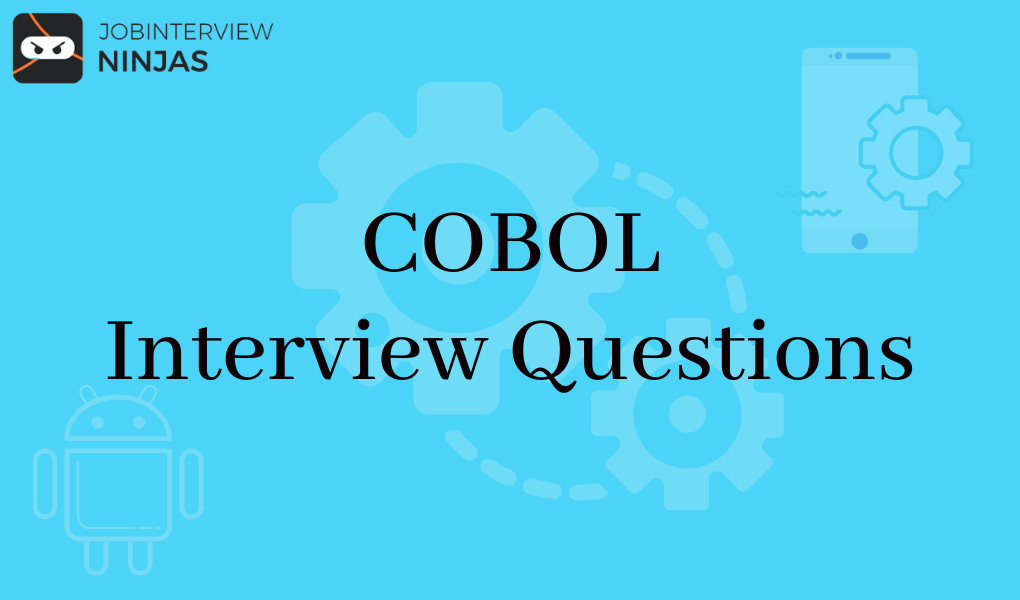
Top 40 Jenkins Interview Questions And Answers For Freshers/Experienced
If you are looking for a career in software development, then Jenkins is definitely worth exploring. This widely used …

Many candidates face difficulty in acing COBOL interviews, so for them, we have brought top COBOL Interview Questions for practice. These are the questions that are frequently asked by the interviewers. Here you’ll find COBOL Interview Questions and Answers for basic, intermediate, and experienced candidates. These questions are associated with COBOL Programming Language, mainframe, features, and more. So, clear your concepts related to different topics and prepare well for 2022 job interviews.
About COBOL: COBOL was made to perform two major objectives in that one is related to portability (the ability of code to be executed with the lowest modification on computers from various manufacturers) and the second is related to readability (the ease with which a code can be read like ordinary English). In the 1990s COBOL language was widely used.
2. Explain different data types of COBOL language?
3. Differentiate between index and subscript?
4. Differentiate between a section and a paragraph?
5. Differentiate between NEXT SENTENCE & CONTINUE?
7. Explain static and dynamic linking?
8. Explain the application of the EVALUATE statement?
9. Tell the importance of the REPLACING option of a copy statement?
10. Explain the role of the ON SIZE ERROR option in trapping error?
11. Differentiate between Structured COBOL Programming and Object-Oriented COBOL programming?
12. Describe LOCAL-STORAGE SECTION?
13. Describe INPUT PROCEDURE and OUTPUT PROCEDURE?
14. What is the application of LINKAGE SECTION?
15. Explain access modes of START statements?
16. Differentiate between Call and a Link?
17. Tell me about the use of COMP and COMP-3?
18. Tell the steps to follow to make a COBOL program suitable?
19. Name different sections of data division?
20. Describe an in-line PERFORM?
21. Name the program divisions that are mandatory for a COBOL program?
22. Differentiate between Global and External Variables?
23. What do you understand from Pic 9v99?
24. Tell me some guidelines that you need to follow while creating a structured COBOL program?
25. Tell the way to find out the present date from a system with the century?
26. Name the different divisions of COBOL?
27. Differentiate between SSRANGE and NOSSRANGE?
28. Differentiate between COMP-1 and COMP-2?
29. Tell me the use of the 77 level?
30. Tell me the use of 88 level?
32. Tell me the use of the IS NUMERIC clause?
33. Can the OCCURS clause take place at the 01 level?
34. Explain index and subscript?
35. Explain sorting order for SEARCH ALL?
37. Name the Search verbs are equal to PERFORM…VARYING?
38. What mode is used for managing the sequential file and how can you describe arrays in COBOL?
39. Explain scope terminator with examples.
40. Explain the use of Pointer in the string?
41. Differentiate between a binary search and a sequential search?
42. Tell some rules to perform a SEARCH?
43. What is the case where scope terminator is mandatory?
44. The file needs to be opened in I-O mode for REWRITE purposes. State the reason?
2. Explain different data types of COBOL language?
3. Differentiate between index and subscript?
4. Differentiate between a section and a paragraph?
5. Differentiate between NEXT SENTENCE & CONTINUE?
7. Explain static and dynamic linking?
8. Explain the application of the EVALUATE statement?
9. Tell the importance of the REPLACING option of a copy statement?
The REPLACING option authorizes the use of the same copy many times; it modifies the replace value in the exact code.
The coding used is COPY
10. Explain the role of the ON SIZE ERROR option in trapping error?
11. Differentiate between Structured COBOL Programming and Object-Oriented COBOL programming?
Structured programming can be described as a logical way of programming. In structured programming, the functionalities are split into modules and help the developer to write the program logically.
Object-Oriented COBOL programming is a realistic way of programming. Here, developers determine the objects and then write functions and techniques around that object.
12. Describe LOCAL-STORAGE SECTION?
13. Describe INPUT PROCEDURE and OUTPUT PROCEDURE?
In the INPUT PROCEDURE, the input file is unlocked and its records are read and reworked. These records are further discharged to the sorting operation and after that finally, the file will be closed.
In the OUTPUT PROCEDURE, the output file is unlocked, the sorted record is brought back to the Output record, and after it, the record will finally be written and then the file will be closed.
14. What is the application of LINKAGE SECTION?
15. Explain access modes of START statements?
16. Differentiate between Call and a Link?
17. Tell me about the use of COMP and COMP-3?
18. Tell the steps to follow to make a COBOL program suitable?
If DB2 program, make a plan by binding the DBRMs
19. Name different sections of data division?
20. Describe an in-line PERFORM?
By using an IN-LINE PERFORM statement the routine is being executed to be nested in the perform statement rather than being an individual paragraph.
While the PERFORM and END-PERFORM statements help block the COBOL statements between them, in-line PERFORM works as long as there are no inner GO TOs, not even to an exit.
21. Name the program divisions that are mandatory for a COBOL program?
22. Differentiate between Global and External Variables?
23. What do you understand from Pic 9v99?
24. Tell me some guidelines that you need to follow while creating a structured COBOL program?
25. Tell the way to find out the present date from a system with the century?
26. Name the different divisions of COBOL?
27. Differentiate between SSRANGE and NOSSRANGE?
28. Differentiate between COMP-1 and COMP-2?
29. Tell me the use of the 77 level?
30. Tell me the use of 88 level?
32. Tell me the use of the IS NUMERIC clause?
33. Can the OCCURS clause take place at the 01 level?
34. Explain index and subscript?
Subscript signifies the array occurrence, whereas the index is the displacement (in bytes) from the beginning of the array. An index can only be changed using PERFORM, SET & SEARCH.
Programmers require having an index for a table to utilize SEARCH, SEARCH ALL.
35. Explain sorting order for SEARCH ALL?
37. Name the Search verbs are equal to PERFORM…VARYING?
38. What mode is used for managing the sequential file and how can you describe arrays in COBOL?
For using a sequential file, an O-I mode (Output/Input mode) is utilized at the beginning and initiation of the processing files. Then Processing of files is defined by the successful implementation of an OPEN statement.
In COBOL, arrays can be described in the following way:
39. Explain scope terminator with examples.
40. Explain the use of Pointer in the string?
41. Differentiate between a binary search and a sequential search?
In binary search, the table component key values are in ascending or descending order. The table is ‘halved’ to search for equivalent to, less than, or greater than necessities until the element is found.
In a sequential search, the table is explored from top to bottom. For this, searching the component does not have to be in a specific sequence.
The binary search is much quicker for more tables, while sequential Search functions very well with lesser tables. SEARCH ALL is utilized for binary search, while SEARCH is utilized for sequential search.
42. Tell some rules to perform a SEARCH?
43. What is the case where scope terminator is mandatory?
44. The file needs to be opened in I-O mode for REWRITE purposes. State the reason?

If you are looking for a career in software development, then Jenkins is definitely worth exploring. This widely used …

In this post, we will cover a few Linux interview questions and their answers. So, let’s get started. In this …